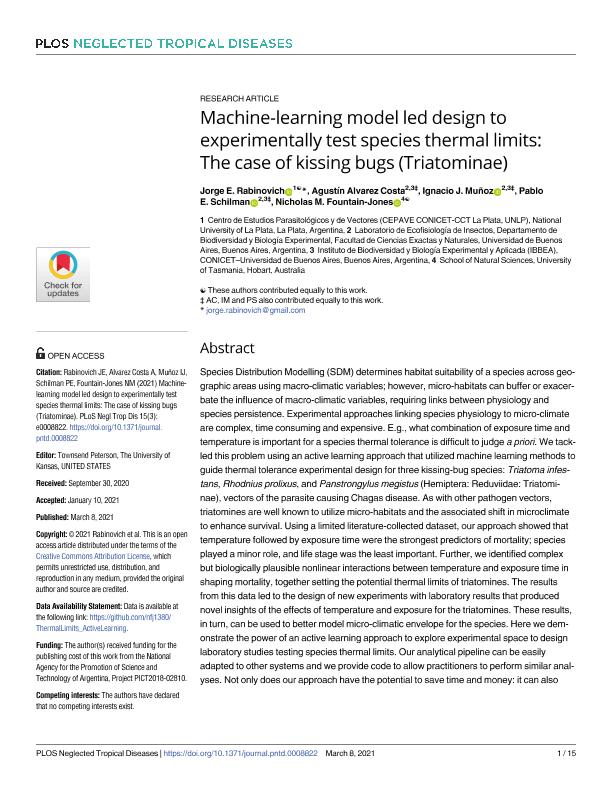Mostrar el registro sencillo del ítem
dc.contributor.author
Rabinovich, Jorge Eduardo

dc.contributor.author
Alvarez Costa, Agustin

dc.contributor.author
Muñoz, Ignacio Joaquín

dc.contributor.author
Schilman, Pablo Ernesto

dc.contributor.author
Fountain Jones, Nicholas M.
dc.date.available
2022-12-22T10:22:29Z
dc.date.issued
2021-03
dc.identifier.citation
Rabinovich, Jorge Eduardo; Alvarez Costa, Agustin; Muñoz, Ignacio Joaquín; Schilman, Pablo Ernesto; Fountain Jones, Nicholas M.; Machine-learning model led design to experimentally test species thermal limits: The case of kissing bugs (triatominae); Public Library of Science; PLoS Neglected Tropical Diseases; 15; 3; 3-2021; 1-15
dc.identifier.issn
1935-2727
dc.identifier.uri
http://hdl.handle.net/11336/182104
dc.description.abstract
Species Distribution Modelling (SDM) determines habitat suitability of a species across geographic areas using macro-climatic variables; however, micro-habitats can buffer or exacer-bate the influence of macro-climatic variables, requiring links between physiology and species persistence. Experimental approaches linking species physiology to micro-climate are complex, time consuming and expensive. E.g., what combination of exposure time and temperature is important for a species thermal tolerance is difficult to judge a priori. We tack-led this problem using an active learning approach that utilized machine learning methods to guide thermal tolerance experimental design for three kissing-bug species: Triatoma infes-tans, Rhodnius prolixus, and Panstrongylus megistus (Hemiptera: Reduviidae: Triatomi-nae), vectors of the parasite causing Chagas disease. As with other pathogen vectors, triatomines are well known to utilize micro-habitats and the associated shift in microclimate to enhance survival. Using a limited literature-collected dataset, our approach showed that temperature followed by exposure time were the strongest predictors of mortality; species played a minor role, and life stage was the least important. Further, we identified complex but biologically plausible nonlinear interactions between temperature and exposure time in shaping mortality, together setting the potential thermal limits of triatomines. The results from this data led to the design of new experiments with laboratory results that produced novel insights of the effects of temperature and exposure for the triatomines. These results, in turn, can be used to better model micro-climatic envelope for the species. Here we demonstrate the power of an active learning approach to explore experimental space to design laboratory studies testing species thermal limits. Our analytical pipeline can be easily adapted to other systems and we provide code to allow practitioners to perform similar anal-yses. Not only does our approach have the potential to save time and money: it can also increase our understanding of the links between species physiology and climate, a topic of increasing ecological importance.
dc.format
application/pdf
dc.language.iso
eng
dc.publisher
Public Library of Science

dc.rights
info:eu-repo/semantics/openAccess
dc.rights.uri
https://creativecommons.org/licenses/by-nc-sa/2.5/ar/
dc.subject
Machine-learning modelling
dc.subject
Triatoma infestans
dc.subject
Temperature
dc.subject.classification
Zoología, Ornitología, Entomología, Etología

dc.subject.classification
Ciencias Biológicas

dc.subject.classification
CIENCIAS NATURALES Y EXACTAS

dc.title
Machine-learning model led design to experimentally test species thermal limits: The case of kissing bugs (triatominae)
dc.type
info:eu-repo/semantics/article
dc.type
info:ar-repo/semantics/artículo
dc.type
info:eu-repo/semantics/publishedVersion
dc.date.updated
2022-09-07T18:33:03Z
dc.identifier.eissn
1935-2735
dc.journal.volume
15
dc.journal.number
3
dc.journal.pagination
1-15
dc.journal.pais
Estados Unidos

dc.description.fil
Fil: Rabinovich, Jorge Eduardo. Consejo Nacional de Investigaciones Científicas y Técnicas. Centro Científico Tecnológico Conicet - La Plata. Centro de Estudios Parasitológicos y de Vectores. Universidad Nacional de La Plata. Facultad de Ciencias Naturales y Museo. Centro de Estudios Parasitológicos y de Vectores; Argentina
dc.description.fil
Fil: Alvarez Costa, Agustin. Consejo Nacional de Investigaciones Científicas y Técnicas. Oficina de Coordinación Administrativa Ciudad Universitaria. Instituto de Biodiversidad y Biología Experimental y Aplicada. Universidad de Buenos Aires. Facultad de Ciencias Exactas y Naturales. Instituto de Biodiversidad y Biología Experimental y Aplicada; Argentina
dc.description.fil
Fil: Muñoz, Ignacio Joaquín. Consejo Nacional de Investigaciones Científicas y Técnicas. Oficina de Coordinación Administrativa Ciudad Universitaria. Instituto de Biodiversidad y Biología Experimental y Aplicada. Universidad de Buenos Aires. Facultad de Ciencias Exactas y Naturales. Instituto de Biodiversidad y Biología Experimental y Aplicada; Argentina
dc.description.fil
Fil: Schilman, Pablo Ernesto. Consejo Nacional de Investigaciones Científicas y Técnicas. Oficina de Coordinación Administrativa Ciudad Universitaria. Instituto de Biodiversidad y Biología Experimental y Aplicada. Universidad de Buenos Aires. Facultad de Ciencias Exactas y Naturales. Instituto de Biodiversidad y Biología Experimental y Aplicada; Argentina
dc.description.fil
Fil: Fountain Jones, Nicholas M.. University of Tasmania; Australia
dc.journal.title
PLoS Neglected Tropical Diseases
dc.relation.alternativeid
info:eu-repo/semantics/altIdentifier/doi/http://dx.doi.org/10.1371/journal.pntd.0008822
Archivos asociados
